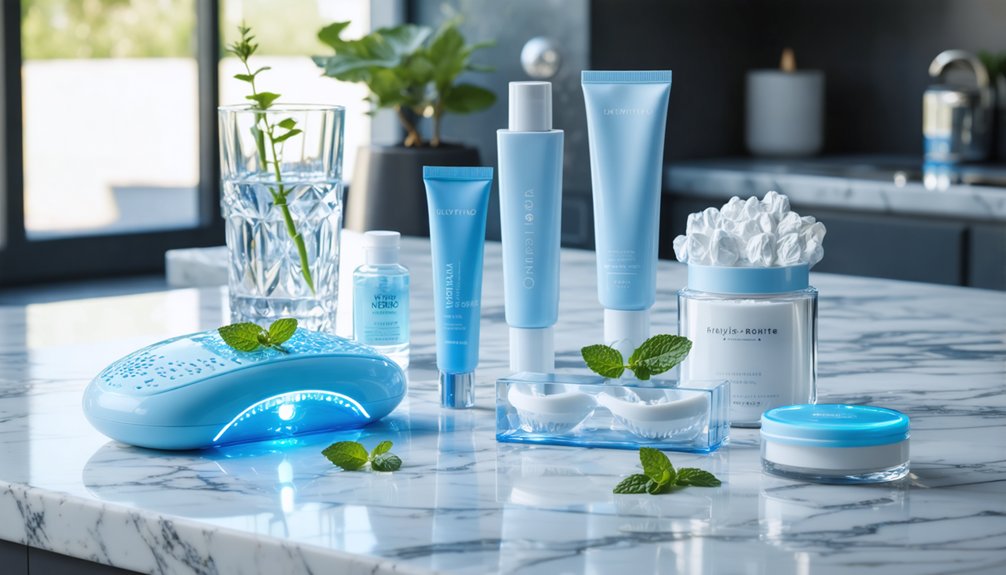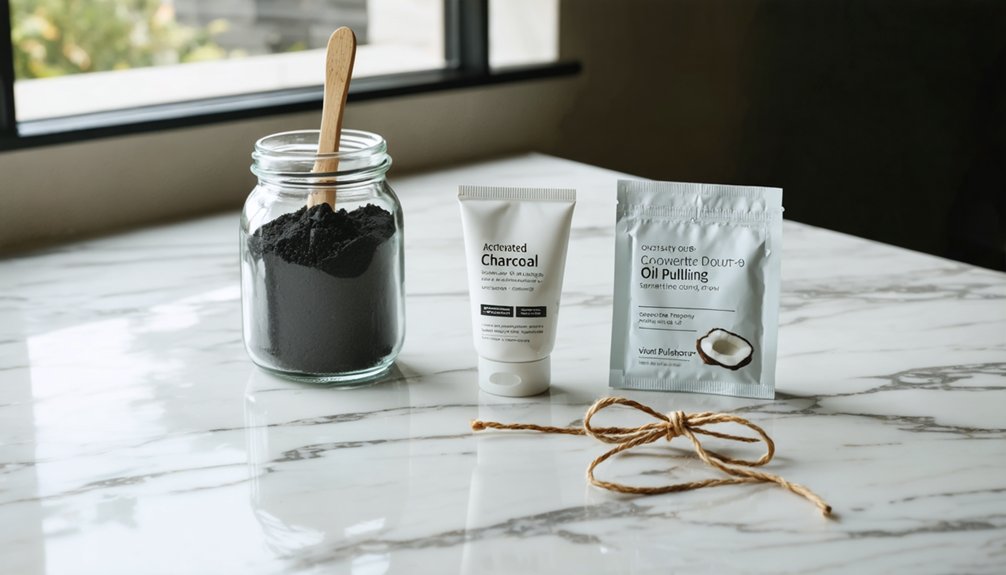While tooth whitening can cause temporary sensitivity, it won’t permanently damage your enamel when done properly. Professional supervision guarantees safe treatment through custom-fitted trays and appropriate bleaching concentrations, while over-the-counter options offer less predictable results. You’ll typically experience mild to moderate sensitivity that peaks after treatment but resolves within 24 hours to two weeks through natural remineralization. Understanding the facts about whitening sensitive teeth will help you make informed choices for your smile.
Key Takeaways
- Teeth whitening causes temporary sensitivity in 30-78% of patients but does not permanently damage tooth enamel with proper application.
- Professional supervision allows customized treatment plans and immediate adjustments to minimize sensitivity while achieving optimal results.
- Natural remineralization typically resolves whitening-related sensitivity within two weeks, with most cases improving within 24 hours.
- Desensitizing agents containing potassium nitrate can effectively manage discomfort during professional whitening treatments.
- Over-the-counter products may save money initially but can lead to inconsistent results and increased sensitivity without professional guidance.
Understanding Tooth Sensitivity and Whitening: The Facts
While teeth whitening remains one of the most popular cosmetic dental procedures, its relationship with tooth sensitivity warrants careful consideration.
The science behind sensitivity reveals how whitening agents affect your tooth anatomy, temporarily demineralizing enamel and potentially irritating nerve endings in the dentin layer beneath. Proper use of peroxide-based bleaching treatments has been proven safe and effective through extensive clinical trials. With teeth whitening treatments showing a 90% success rate, more patients are opting for professional solutions despite sensitivity concerns.
You’ll find that sensitivity affects between 30% and 78% of patients during whitening treatments, with sensitivity causes ranging from exposed dentin to gum recession.
The good news is that most cases are mild to moderate and resolve within days. Understanding these patterns helps set realistic expectations: sensitivity typically peaks immediately after treatment and diminishes within 24 hours.
For your peace of mind, complete resolution usually occurs within two weeks, and the temporary demineralization reverses naturally through normal salivary flow.
Common Misconceptions About Enamel Damage
While whitening treatments may cause temporary tooth sensitivity, they don’t permanently damage your enamel when used as directed.
You’ll find that proper application and following professional guidelines considerably reduces any risk to your tooth structure.
Understanding the difference between temporary sensitivity and actual enamel damage helps you make informed decisions about teeth whitening treatments. Professional treatments using hydrogen peroxide compounds effectively remove stains while preserving enamel integrity. Regular dental checkups ensure safe and optimal whitening results.
Understanding Temporary Enamel Changes
Since many people worry about damaging their teeth during whitening treatments, it’s important to understand that most enamel changes are temporary rather than permanent.
Your teeth may appear whiter immediately after treatment due to temporary changes in enamel hydration, but this effect will normalize within 2-3 days as your teeth rehydrate.
When using whitening products properly, you can expect:
- Initial dehydration of enamel causing a temporary whiter appearance
- Short-term surface softening that reverses through natural remineralization
- Recovery of normal enamel microhardness, especially when supervised by dental professionals
Professional supervision guarantees these temporary changes don’t become permanent issues. Consulting a dentist before treatment is crucial since sensitive teeth may require specialized whitening approaches.
While your enamel may experience brief periods of increased sensitivity or softness, these effects typically resolve on their own through proper dental care and appropriate treatment intervals. The active ingredient hydrogen peroxide gradually breaks down stains without causing lasting damage to tooth structure.
Safe Application Prevents Damage
Despite common fears about enamel damage, professionally supervised teeth whitening treatments don’t erode or thin tooth enamel when applied correctly. The peroxide-based gels used in professional treatments target stains within the tooth structure while preserving enamel integrity.
You’ll find that temporary sensitivity after whitening doesn’t indicate enamel degradation but rather a brief nerve response that typically resolves quickly. Under professional supervision, your dentist will customize whitening frequency and monitor treatment progress to prevent adverse effects. Since enamel is the hardest material in your body, it maintains its protective strength even after whitening treatments. Dentists often recommend waiting 6-12 months between whitening sessions to ensure optimal safety.
While over-the-counter products may carry risks from misuse, dental-approved treatments maintain strict safety standards. To protect your enamel, avoid DIY remedies with acidic ingredients and highly abrasive whitening toothpastes. Instead, trust your dental professional’s guidance on proper application techniques and maintenance protocols.
Professional vs. Over-the-Counter Whitening Options
While professional whitening treatments offer superior safety through dental supervision and precise control of bleaching agents, over-the-counter options can’t match this level of protection for your sensitive teeth. Professional treatments use high-concentration gels that deliver dramatic results in a single session.
You’ll find that professional treatments’ higher initial cost is often offset by their longer-lasting results and reduced need for repeated applications compared to OTC products. Dentists provide essential follow-up care to ensure optimal whitening outcomes and address any concerns.
The custom-fitted trays and protective barriers used in professional whitening provide more consistent coverage and better gum protection than generic OTC strips or trays, which can lead to uneven results and increased sensitivity.
Safety and Control Differences
When choosing between professional and over-the-counter teeth whitening options, safety and control emerge as critical differentiating factors.
Professional oversight guarantees proper application techniques and immediate management of any sensitivity issues, while treatment personalization addresses your unique dental anatomy and concerns.
- Your dentist will create custom-fitted trays or use precise in-office techniques that protect soft tissues and guarantee even distribution of whitening agents.
- Professional treatments utilize protective barriers and specialized tools to prevent gum irritation while applying higher-concentration whitening agents.
- Your treatment plan will be monitored and adjusted based on individual responses, helping prevent enamel damage and reducing the risk of sensitivity.
This controlled approach delivers predictable results while maintaining the health of your teeth and gums, unlike the potential risks associated with unsupervised OTC products.
Cost vs. Long-Term Results
Understanding the cost-benefit relationship between professional and over-the-counter teeth whitening requires careful consideration of both initial investments and long-term value.
While professional treatments may cost between $300-$1,800 upfront, their superior treatment longevity often justifies the expense, lasting up to three years with proper maintenance.
A thorough cost analysis reveals that OTC products, despite lower initial costs of $5-$60, can accumulate expenses exceeding $150 annually when used regularly.
Professional whitening’s higher peroxide concentrations (15-43%) achieve 7-8 shade improvements in a single session, compared to OTC products’ gradual results from lower concentrations (3-20%).
Additionally, professional options often include expert supervision and custom-fitted trays, reducing the risk of sensitivity issues that could lead to additional dental expenses.
Application Method Comparison
Professional and over-the-counter teeth whitening methods differ greatly in their application approaches and effectiveness. When selecting between these options, you’ll find that application techniques considerably impact your whitening results.
Professional treatments utilize custom-fitted trays and precise product selection based on your specific dental needs, ensuring ideal coverage and minimal sensitivity.
- Professional application involves protective barriers and controlled gel placement, preventing soft tissue irritation and ensuring even distribution.
- Over-the-counter products rely on generic-fit strips or trays that may not adequately cover all tooth surfaces, leading to inconsistent results.
- Dental professionals can modify application techniques during treatment based on your sensitivity levels and response, while OTC methods offer no such flexibility.
The supervised approach allows for immediate adjustments and maximizes the effectiveness of stronger whitening agents, delivering more predictable outcomes.
Natural Remedies: Separating Truth From Fiction

Despite widespread interest in natural teeth whitening solutions, many popular home remedies can pose significant risks for those with sensitive teeth.
While certain natural ingredients like activated charcoal and baking soda show whitening effectiveness, they can damage enamel through excessive abrasion. Acidic fruits, particularly lemons and strawberries, may temporarily whiten teeth but ultimately weaken enamel structure, increasing sensitivity and decay risk.
You’ll achieve safer results by focusing on preventive measures. Choose crunchy fruits and vegetables that naturally cleanse teeth while stimulating protective saliva production.
Consider sugar-free gum between meals, and use a straw when consuming staining beverages. If you’re concerned about tooth sensitivity, consult your dentist before trying natural whitening methods, as they may worsen discomfort and cause uneven coloration, especially with dental restorations.
Managing Sensitivity During the Whitening Process
When teeth whitening causes discomfort, you’ll need a thorough sensitivity management strategy both before and during treatment.
Professional supervision guarantees proper treatment adjustments based on your comfort level, while specialized desensitizing agents containing potassium nitrate help block nerve pathways and reduce discomfort.
- Apply fluoride gels or varnish during whitening sessions to protect your enamel and soothe teeth.
- Monitor treatment intensity and adjust bleaching intervals according to your sensitivity response.
- Use customized trays with lower peroxide concentrations for gentler application.
To maximize comfort, avoid excessive whitening frequency and duration.
Instead, opt for gradual treatments that allow your teeth to adjust. Your dentist can modify the whitening formula and application method based on your specific sensitivity levels, guaranteeing effective results without compromising comfort.
Customizing Your Whitening Treatment Plan

Creating a customized whitening treatment plan begins with selecting the right combination of trays, gels, and application schedules for your specific sensitivity needs.
Your dentist will craft custom-fitted trays from dental impressions to guarantee precise gel application while minimizing gum contact and sensitivity risks.
Custom dental trays ensure targeted whitening application and reduced sensitivity through precise impressions that protect your gum tissue.
This tailored treatment incorporates professional-grade whitening gels with adjusted peroxide concentrations and desensitizing agents suited to your comfort level.
Through this personalized approach, you’ll follow a gradual whitening schedule with shorter sessions and strategic recovery periods between treatments.
Pre-treatment protocols may include desensitizing toothpaste use and professional fluoride applications to strengthen your enamel.
Your dentist will monitor your progress throughout the process, making real-time adjustments to optimize results while maintaining your comfort during the whitening journey.
What to Expect From Your Whitening Results
Results from professional tooth whitening treatments typically emerge within 7-14 days of consistent use, with shade improvements ranging from 4 to 9.5 levels on standard dental scales.
Your whitening expectations should account for the treatment method you’ve chosen, as in-office procedures with higher peroxide concentrations deliver faster results compared to at-home options.
- In-office treatments using 40% hydrogen peroxide can show visible changes within 24 hours.
- At-home treatments with 10-16% carbamide peroxide produce gradual improvements over 1-2 weeks.
- Combined treatments don’t necessarily enhance results and may increase sensitivity risk.
Understanding these treatment timelines helps you set realistic goals.
While most patients experience noticeable improvements, individual results vary based on product type and application consistency.
You’ll typically see the most dramatic changes during the first two weeks of treatment.
Frequently Asked Questions
Can I Whiten Teeth With Existing Dental Work Like Crowns or Bridges?
You can’t whiten existing crowns or bridges since whitening only affects natural teeth. Your surrounding teeth will whiten, creating noticeable contrast. Consider replacing restorations to match your desired shade.
How Soon After a Dental Cleaning Should I Wait Before Whitening?
You can begin whitening immediately after a dental cleaning if your gums aren’t inflamed or bleeding. However, if you’re experiencing sensitivity or gum irritation, wait 3-5 days before starting your whitening timeline.
Will Whitening Affect the Strength of My Tooth Bonding Material?
Yes, whitening will weaken your bonding material’s strength, particularly within 24 hours of treatment. You’ll need to wait at least two weeks after whitening before getting any new dental bonding procedures.
Is It Safe to Whiten Teeth While Pregnant or Breastfeeding?
While whitening safety during pregnancy isn’t conclusively proven, you should delay treatment until after delivery. You can safely whiten while breastfeeding, but always consult your healthcare provider before proceeding with any treatment.
Can Medications Influence the Effectiveness of Tooth Whitening Treatments?
Yes, your medications can considerably impact treatment efficacy through medication interactions. Both intrinsic stains from antibiotics and extrinsic stains from other drugs can reduce whitening’s effectiveness, requiring specialized approaches.
References
- https://castrovalleydentist.dental/the-truth-behind-common-teeth-whitening-myths/
- https://www.creeksidefamilydental.com/teeth-whitening-myths-debunked-separating-fact-from-fiction/
- https://admcare.com/teeth-whitening-for-sensitive-teeth-facts-and-fiction/
- https://windhamdentist.com/teeth-whitening-myths-and-facts/
- https://massdentalassociates.info/teeth-whitening-myths-vs-facts-what-you-need-to-know/
- https://gentledental.interdent.com/resources/facts-myths-about-teeth-whitening
- https://www.drmarcano.com/blog/10-popular-teeth-whitening-myths-that-are-just-plain-wrong
- https://www.pecanstdental.com/teeth-whitening/teeth-whitening-myths-debunked-separating-fact-from-fiction/
- https://www.nydentalboutique.com/post/common-myths-about-teeth-whitening
- https://www.loudfamilydentistry.com/blog/teeth-whitening-related-statistics-on-effectiveness-and-sensitivity-incidence



